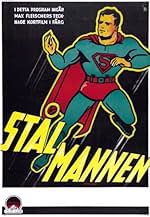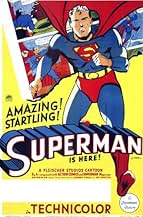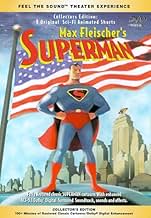Primer cortometraje de animación de los Estudios Fleischer adaptando a Superman. Un malvado científico ha secuestrado a Lois Lane y amenaza con destruir Metrópolis con un peligroso rayo. Sól... Leer todoPrimer cortometraje de animación de los Estudios Fleischer adaptando a Superman. Un malvado científico ha secuestrado a Lois Lane y amenaza con destruir Metrópolis con un peligroso rayo. Sólo el Hombre de Acero puede detener al villano.Primer cortometraje de animación de los Estudios Fleischer adaptando a Superman. Un malvado científico ha secuestrado a Lois Lane y amenaza con destruir Metrópolis con un peligroso rayo. Sólo el Hombre de Acero puede detener al villano.
- Dirección
- Guión
- Reparto principal
- Nominado para 1 premio Óscar
- 1 nominación en total
- Clark Kent
- (voz)
- (sin acreditar)
- …
- Lois Lane
- (voz)
- (sin acreditar)
- Perry White
- (voz)
- (sin acreditar)
- The Mad Scientist
- (voz)
- (sin acreditar)
- Narrator
- (voz)
- (sin acreditar)
Reseñas destacadas
Admittedly, their roots go much deeper into literary figures and the Great Depression gave them the first propagating stimulus; but it was still World War II that stimulated the colorful Magazines or Periodicals (Comic "Book" being an obvious malapropism.).
As an example, typical comics' covers of 1941-45 would feature war related illustrations that weren't related to any of the internal stories' content, except in the broadest, most general sense. Heavily symbolic illustrations on Action Comics with Superman saving a Tank crew, Detective Comics with Batman & Robin presenting a G.I. with a new rifle, USA Comics with Captain America kicking Hitler in the nuts, Whiz Comics with Captain Marvel airlifting Refugee Kids to Freedom and Marvel Mystery featuring Sub-Mariner sinking a U Boat while The Human Torch burns the wing off of a Messerschmitt.
There is little wonder that the Super-Hero would soon move off of the comics page to the daily newspaper strip, Radio Programs, Movie Serials and the Animated Cartoon Short. (Television was still off in the not too distant future.) And leading the parade was that Strange Visitor from another Planet, the Man of Steel (Himself), Superman! The first roll on the Monopoly Board landed Superman on Mutual Radio's Network in 1940. This gave the World The Adventures of Superman 15 minute daily serialized program. The cast featured Bud Collyer's multi-ranged vocals voicing both the mild mannered, high pitched Clark Kent as well as the richer, deeper and powerful Superman. Miss Joan Alexander did Lois Lane with Announcer (" .The Adventures of Syue-Puhr-Man!") Jackson Beck did Perry White. (As for Cub Reporter, Jimmy Olsen, he didn't appear until later in the decade, originating on the Radio, not in the comics, as Jimmy, the Office Boy.)
When the deal was struck between Superman's copyright owner, DC Comics/National Comics Publications and the Fleischer Brothers Animation Studios, tendering the rights to produce the first Superman animated series, the decision was made to retain the services of Mr. Collyer, Miss Alexander and Mr. Beck to reprise their voice characterizations.
So the first cartoon was on the drawing board. Not surprisingly, it would contain the obligatory origin sequence. But in dealing with this in a rapid, sort of re-cap style; Max & Dave and company avoided using-up a whole cartoon; thus allowing the story of 'The Mad Scientist' (alternate & possibly working title). As for this story it is sort of typical, but gained in status by being the first with Superman (or any other Super Hero, for that matter).
OUR STORY (at last) ..The Editorial Offices of THE METROPOLIS DAILY PLANET are inundated with reports of wanton destruction of bridges, buildings and urban infrastructure of the City. The Editor (called oddly enough, "Chief" wants Clark Kent to investigate, but spunky Lois Lane, Girl Reporter, is determined to scoop Kent, only to be taken hostage by the Evil, Mad Scientist. (Is there any other kind?) Superman shows up, saves Lois from being consumed in molten metal and apprehends the villainous (Is there any other kind?) renegade genius. Lois gets scoop and by line. Clark establishes a series long custom of winking at the audience as ironic conversation about the adventure fills the Planet's Editorial Office.
WE feel obligated to two neat, little touches that made for a much better first episode. First is the use of the Mad Doctor's pet anthropomorphic cuddly vulture. Secondly we salute the eerie, hauntingly bizarre voice of the MAD SCIENTIST; which we just discovered was provided by Mr. Jack Mercer, famous for Popeye's gravely voice.
The series hasn't a real klunker in the whole bunch; though naturally, some individual cartoons will be found to be better than others. We noticed that the shorts produced at the Fleischer Studios auspices seem superior to those made after that notorious coup-de-tat that transformed the animation house into Paramount's Famous Studios.
EDITOR'S NOTE: Warning! Achtung! Cuidado! When you get your Tape or Whole DVD Set, do not attempt to view multiple shorts, one after another. Doing your watching in this manner tends to render them seemingly repetitive, monotonous and boring even; kinda like attempting a 3 Stooges marathon of shorts featuring Joe Besser. Try instead to do your viewings interspersed with other features.
After all, this is truly " ..Truth, Justice and the American Way!"
The New York Times said of this cartoon " {this cartoon} is among the brothers' less successful efforts. The Fleischers show so little aptitude for -or interest in-realistic animation styles. Superman and Lois Lane are at their most wooden. So is the story's villain, a mad scientist. But the scientist's raven is wildly alive, like any real Fleischer creation, and the film sneaks in as many raven's-eye glimpses as possible. Heroic human figures have little to do with the grim, witty hallmarks of the Fleischers' imagination."
I must disagree with the Times' opinion. If one was to look at Superman comic strips from this point of time, one would see that the Superman of the comic books and the Superman of the cartoons, looks essentially the same. Yes, the raven is the most "cartoon" like character in the cartoon, but the film is still enjoyable, and is a snapshot of what cartoons were like right before the start of WWII.
A mad scientist turns his death ray on Metropolis to begin destroying bridges & buildings. Intrepid reporter Lois Lane crashes her plane directly in the madmans front yard. With Lois a prisoner & the death ray once again in operation, it looks like a job for SUPERMAN!
This was the first in a series of excellent cartoons Max Fleischer produced for Paramount Studio. They feature great animation and taut, fast-moving plots. Meant to be shown in movie theaters, they are miles ahead of their Saturday Morning counterparts.
1. The Superman cartoons formed the first action/adventure/sci-fi cartoon series ever, thus setting the stage for all anime, Saturday morning TV action 'toons, video games and such to come.
2. The Superman series quietly helped disseminate art-deco and other modernist design styles into popular culture.
3. "The Arctic Giant" episode predates the 'giant dinosaur' film cycle by some ten years; the design of the Arctic giant itself was clearly an inspiration for Toho's Godzilla design.
4. The drawing style for the Superman comic books was rather rough, as with most action comics of the type of that era. The Superman cartoons, on the other hand, present a smooth-line style, using dark shadows for modeling. This style was to have a great impact on the "illustrated novel" comic book style that developed in the late '70s - roughly about the time the series was rediscovered by comics/cartoon fans.
5. Fleischer studios apparently simply ignored the Superman live-action serials of the time. Thus rather than pursing convoluted plots only resolved by dialog, they chose a compressed narrative style, with hardly any dialog, which emphasizes the plot as realizable only through action.
6. Because of this compressed narrative style, the Fleischer story writers were the first to be confronted with the perennial Superman dilemma - namely, how to actually threaten a character who is all-powerful and invincible at least to the extent of creating a plot-motivating conflict. They are not always successful - the episode about the escaped circus gorilla is especially unconvincing - but the effort is fascinating, especially since the comic book Superman writers would not really confront the problem until the 1970s (having used the kryptonite ploy to evade the issue for 20 years).
7. Interestingly, the Fleischer Superman series, with its stronger violence and deeper themes, and its commitment to a kind of visual realism, is clearly intended for a more mature audience than the comic books or the live-action serials - despite the fact that it appeared just as major studio cartoon workshops began resigning themselves to entertaining younger audiences.
8. "The Eleventh Hour" episode, with Superman acting as saboteur in a personal war against Japan, was released nearly 3 weeks BEFORE Pearl Harbor. The Fleischers thus had Superman join the fight against Fascism world-wide before the US was finally drawn into the battle.
9. It is true that the cartoon series defines its character and history differently than the comic book version; but this was when the Superman mythos was still in development, and the Fleischers pursued possibilities for the character the comic book writers had not yet considered (for instance, his ability to fly, his invulnerability, the curiously playful relationship between Clark and Lois - which in the cartoons has a real edge of adult romantic attraction that was unavailable to the comic book writers).
It is easy to see why the Superman series did not salvage the Fleischer studios from their ultimate dissolution - they are dark, violent snippets of science fiction drama at a time when audiences were coming to expect cartoon animals playing gags on each other. But it is more difficult to figure out why it lasted for as many episodes as it did. My guess is that the Fleischers realized they were breaking new ground, and were willing to give it as much a chance for success as possible. Unfortunately, they were literally decades ahead of their time. As a particular animated cartoon style, we would not see its like again until the Warner Bros. Batman television series of the 1990s - and by then the idiom was simply accepted as one of many available to animators and cartoon artists.
¿Sabías que...?
- CuriosidadesMax Fleischer and Dave Fleischer were reluctant to take this assignment because it would require much more realistic designs and animation than they usually used. They tried to discourage Paramount by stating they would need a budget of around $100,000 per short, four times the budget of an average Walt Disney cartoon, which then had the highest budgets in animation. To their shock, Paramount executives agreed to at least half the amount, which made the Superman series--in adjusted dollars--the biggest-budgeted animation series in film history.
- Citas
[first lines]
Voices: Up in the sky, look: It's a bird. It's a plane. It's Superman!
Narrator: [opening narration] In the endless reaches of the universe, there once existed a planet known as Krypton, a planet that burned like a green star in the distant heavens. There, civilization was far advanced and it brought forth a race of "supermen," whose mental and physical powers were developed to the absolute peak of human perfection. But there came a day when giant quakes threatened to destroy Krypton forever. One of the planet's leading scientists, sensing the approach of doom, placed his infant son in a small rocket ship and sent it hurtling in the direction of the Earth just as Krypton exploded. The rocket ship sped through star-studded space, landing safely on Earth with its precious burden: Krypton's sole survivor. A passing motorist found the uninjured child and took it to an orphanage. As the years went by and the child grew to maturity, he found himself possessed of amazing physical powers. Faster than a speeding bullet, more powerful than a locomotive, able to leap tall buildings in a single bound. The infant of Krypton is now the Man of Steel: Superman! To best be in a position to use his amazing powers in a never-ending battle for truth and justice, Superman has assumed the disguise of Clark Kent, mild-mannered reporter for a great metropolitan newspaper.
- Versiones alternativasIn the scene in the editor's office, when Lois Lane runs off to "follow up her lead," Clark Kent originally asked Perry White, "Don't you think that's a dangerous mission for a girl?" In most current prints, the scene is cut so that the line now ends on the word "mission."
- ConexionesEdited into Fantastic Animation Festival (1977)
Selecciones populares
Detalles
- Fecha de lanzamiento
- País de origen
- Sitio oficial
- Idioma
- Títulos en diferentes países
- Superman: The Mad Scientist
- Empresa productora
- Ver más compañías en los créditos en IMDbPro
Taquilla
- Presupuesto
- 50.000 US$ (estimación)
- Duración10 minutos
- Relación de aspecto
- 1.37 : 1
























